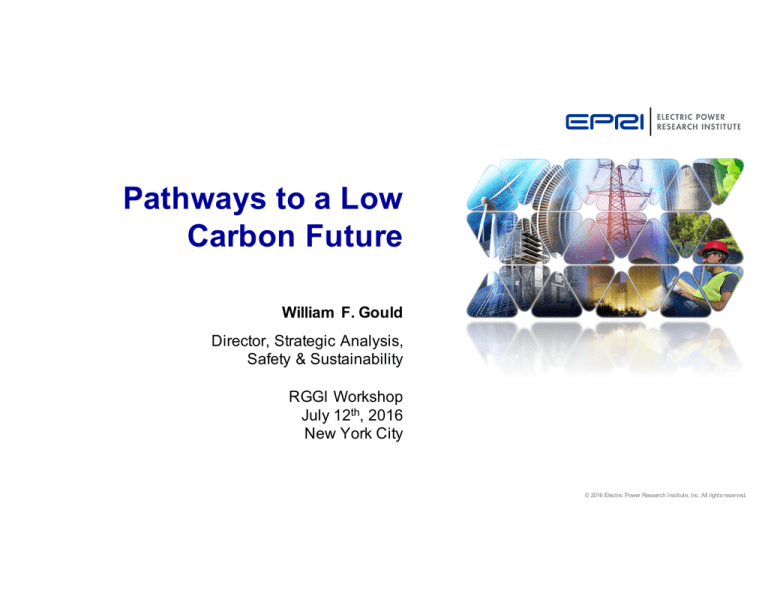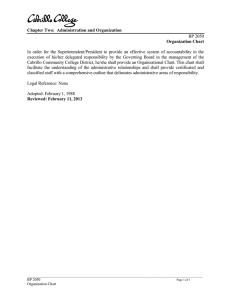
Pathways to a Low
Carbon Future
William F. Gould
Director, Strategic Analysis,
Safety & Sustainability
RGGI Workshop
July 12th, 2016
New York City
© 2016 Electric Power Research Institute, Inc. All rights reserved.
Electric Power Research Institute
§ Unique Collaborative Business Model
§ World-wide Members
– 450+ participants in more than 30 countries
– 90% of the electricity in the United States generated by EPRI members
– 30% of research, development and demonstrations international
funding
2
© 2016 Electric Power Research Institute, Inc. All rights reserved.
Clean Power Plan and COP21
Are actions to comply with CPP consistent with steps
for greater carbon reductions? (Are RGGI’s?)
3
© 2016 Electric Power Research Institute, Inc. All rights reserved.
US-REGEN 48 State Version: EPRI’s In-House Electric Sector and Economy Model
1200
Capacity Expansion Economic
Model, Long Horizon to 2050
1000
GW
800
600
400
P
a
ci
fi
c
N
N
E
Y
Mo
unt
ain
-S
200
0
2015
2025
2030
2035
2040
2045
State Level Resolution for Policy
and Regulation Analysis
Innovative Algorithms to Capture
Wind, Solar, & Load Correlations
in a Long Horizon Model
4
2020
© 2016 Electric Power Research Institute, Inc. All rights reserved.
2050
Continuing Insights…
§ Simple rate vs mass compliance:
– Rate: renewables (wind), energy efficiency, gas re-dispatch
– Mass: more gas generation
§ Compliance pathways selections of each state can have significant impact
on every other state;
§ Markets for allowances and ERCs could reduce compliance costs, but add
additional risks;
§ Actions associated with CPP compliance are not necessary compatible
with longer term Carbon reduction requirements
5
© 2016 Electric Power Research Institute, Inc. All rights reserved.
U.S. Greenhouse Gas Reduction (GHG) Pledge is an Economy-wide Reduction
of 28% by 2025; Longer-term Goal of 80% by 2050
8
7
CH4, N20, and F-gases
Net GHG (incl sinks)
BilliontonsCO2eq.
6
5
Economy 28% target
4
Non-ELECTRIC SECTOR CO2
3
Economy
80% target
2
Clean Power Plan 32% target
1
ELECTRIC SECTOR CO2
0
2010
2015
2020
nominal Electric Sector 80% target
2025
2030
2035
Source: US-REGEN data; Energy Modeling Forum 24
6
© 2016 Electric Power Research Institute, Inc. All rights reserved.
2040
2045
2050
U.S. Greenhouse Gas Reduction Targets:
8What
Role will the Electric Sector Play in Economy Reductions?
7
CH4, N20, and F-gases
Net GHG (incl sinks)
BilliontonsCO2eq.
6
5
Economy 28% target
How
will
they
get
there?
OTHER SECTORS OF
THE ECONOMY MUST
REDUCE
4
Non-ELECTRIC SECTOR CO2
3
Economy
80% target
2
1
Electric
Sector
ELECTRIC SECTOR CO2
0
2010
2015
2020
2025
2030
2035
2040
2045
2050
Rest of economy must make dramatic reductions – HOW?
7
Source: US-REGEN data; Energy Modeling Forum 24
© 2016 Electric Power Research Institute, Inc. All rights reserved.
Electric Sector:
We can get from here to there…
Economic & Technological “line of sight”
to Low Carbon Future…
…Critical in enabling decarbonization of
other Sectors of Economy!
8
© 2016 Electric Power Research Institute, Inc. All rights reserved.
Pathway of Cleaner Electricity/Energy Generation ~2050
Generation IV Nuclear
Large-Scale Storage
Advanced Power Cycles
(e.g., Supercritical CO2 Cycle)
(co-production – electricity, hydrogen steam)
Technology innovation
in the next decade will
be key to ensure all
options for cleaner
energy production are
available in the long
term.
High Altitude/Power Wind
Source: Carbon Capture Image – htcco2systems.com; Gen IV Image – KAERI
9
© 2016 Electric Power Research Institute, Inc. All rights reserved.
Gen III Photovoltaic (PV)
Large Value in Extending Existing Nuclear Licenses in the US
Capacity Gain –
80GW in 2050
RemainingNuclearGenerationCapacitybyLicenseLimit
120
100
100
800
700
700
GenerationCapacity(GW)
Generation
Capacity (GW)
GenerationCapacity(GW)
100
8080
80
80-Year
GenerationExpectedtobeLosttoNuclearRetirements
80GW of Nuclear
Nuclear
700
600
600
600
500
500
500
or
~ 240GW of Non60-Year
Hydro
Renewables?
(TWh)
6060
60
40
40
40
900
900
900
800
800
Annual
Generation
AnnualGeneration(TWh)
Annual
Generation
(TWh)
Annual
Generation
(TWh)
LostLost
GenerationCapacity(GW)
120
120
Energy Gain –
700 TWh in 2050
400
400
400
300
300
300
60-Year
Non-Hydro Renewable
200
200
200
20
2020
100
100
100
0
00
2015
2020
2025
2030
2035
2040
2045
2050
2055
2060
2065
2070 2075
2075
2015 2020
2020 2025
2025 2030
2030 2035
2035 2040
2040 2045
2045 2050
2050 2055
2055 2060
2060 2065
2065 2070
2015
80-year
60-year
80-year
60-year
80-Year
Annual Generation
Lost
000
2015
2025
2050
206020602065
2015
2020
20252035
2030
2040
2045
2050
2015 2020
2020
2025 2030
2030
20352040
20402045
20452035
20502055
2055
2065207020702075
80-year 207560-year
80-year
Note: As s umes 92% c apac ity fac tor for nuc lear fleet
> $100 billion present value savings in an 80% 2050 GHG Reduction Scenario
10
© 2016 Electric Power Research Institute, Inc. All rights reserved.
Electric Sector Comprised 31% of US GHG Emissions in 2013
US Greenhouse Gas Emissions by
Source (2013)
Agriculture
9%
Industry
21%
Residential &
Commercial
12%
Electricity
31%
Transportation
27%
3
Source: USEPA 2013
* Land Use, Land-Use Change, and Forestry in the
United States is a net sink and offsets approximately
13% of these greenhouse gas emissions
11
© 2016 Electric Power Research Institute, Inc. All rights reserved.
Transition to a Cleaner Energy Use ~2030
On Road
Vehicles
Cleaner Energy
Use in All
Sectors;
Transportation,
Industrial
Processes,
Heating
12
Non-Road
Vehicles
Industrial
Processes
Natural Gas
Heating
High Speed
Trains
© 2016 Electric Power Research Institute, Inc. All rights reserved.
Integrated
Heat Pump
Pathway of Cleaner Energy Use ~2050
Hydrogen
Stations
Bio Fuel
Teleheating
As electricity sector
gets cleaner, it will
enable other sectors of
the economy to reduce
emissions
Microwave Drying
13
© 2016 Electric Power Research Institute, Inc. All rights reserved.
Commercial
Heat Pumps
Final Energy Use in Transportation (2012)
§ Transportation energy use
– Passenger vehicles
– Trucks
– Aviation
OtherTransport:
- Morelimitedoptionsfor
electrification
– Military
– Freight Rail
– Boats
- Currentmodelcanonlyreduce
demand
– Bus
– Passenger Rail
– Miscellaneous
- Bioenergy/hydrogenpotentially
importanthere
0
5
Electricity
14
10
Gas
Oil
Bioenergy
© 2016 Electric Power Research Institute, Inc. All rights reserved.
15
Quadbtus
EPRI NRDC Study
Environmental Assessment of a Full Electric Transportation Portfolio
Electrification White
Paper March 2016
Electricity Sector
Electric Transportation
Electrifiable Transportation
Overall emissions decline substantially – electrification, along with
transportation efficiency improvements, result in a 70% reduction in GHG
emissions for these two sectors between 2015 and 2050
15
© 2016 Electric Power Research Institute, Inc. All rights reserved.
Promising Innovation for Heavy Vehicle Electrification
Source: Scania press release, June 22, 2016 - 16179-009 Creative Commons 3.0 License
16
© 2016 Electric Power Research Institute, Inc. All rights reserved.
Final Energy Use in Buildings
§ Key areas for decarbonization in buildings:
–
–
–
–
USFinalEnergyDemand
(2010)(residential+
commercial)
Space heating
Water heating
Cooking
Clothes dryers
0
2
Electricity
4
Gas
Oil
6
8
Quadbtus
Renewable
§ Options: electrification, efficiency (appliance and shell), biomass
§ Issues: building stock turnover, cost effective substitutions
17
© 2016 Electric Power Research Institute, Inc. All rights reserved.
Carbon Footprint: Heat Pump Heating
AnnualCO2Emissions,lbs
14,000
12,000
10,000
8,000
6,000
4,000
92% eff. Gas
Furnace
2,000
0
1.5 1.4 1.3 1.2 1.1 1.0 0.9 0.8 0.7 0.6 0.5 0.4 0.3
CarbonIntensityofDeliveredElectricity,lbs/kWh
18
© 2016 Electric Power Research Institute, Inc. All rights reserved.
Final Energy Use by Industry (2012)
Mid-stream
Energy
Refining
Mining / Extraction
Bulk Chemicals
Paper
Other Manufacturi ng
Construction
Iron and Steel
Food
Agriculture
Computers
Transportation Equipment
Aluminum
Fabricated Metal Products
Plastics
Cement and Lime
Wood Products
Glass
Machinery
Electrical Equipment
0
1
Electricity
19
2
Gas
Oil
© 2016 Electric Power Research Institute, Inc. All rights reserved.
3
Coal
Bioenergy
4
Quadbtus
Opportunities for Electrification (Very Regionally Dependent)
Residential
Commercial
Air-source/ground-source heat pumps
Variable capacity ducted heat pumps
Variable refrigerant flow heat pumps
Variable capacity rooftop heat pumps
Rooftop air-source heat pumps
Heat pump pool dehumidification & heating
Forklifts (comm & ind applications)
Industrial
20
Truck stop electrification
Commercial food service equipment
Infrared curing and drying
UV curing
Induction surface treatment
Resistance heating
Channel and coreless induction furnaces
Pipeline compression
Electric resistance (direct) furnaces
C&I heat recovery heat pumps
Robotic milking
Automatic feed pusher
Pumps
© 2016 Electric Power Research Institute, Inc. All rights reserved.
Hypothetical Electrification Scenario Assumptions
Non-Electric
Energy-Use
40
quadBTU
30
20
Buildings
Industry
Passenger
Vehicles
21
Other
Transport
=
Coefficientof
Performance
(COP)=3
1mmbtu
(=0.3MWh)
electricity
replaces3
mmbtu nonelectricfinal
energy
2015
2050
IncreasedElectricity
Demand
(43%above referencein2050)
0.5
i.e.
10
0
“Equivalent” ×
PenetrationShare
Electricity
1
0
TWh
1
2000
0.5
2015
2050
1500
0
1000
1
500
0.5
2015
2050
0
2015
1
0.5
2015
2050
0
© 2016 Electric Power Research Institute, Inc. All rights reserved.
2030
0
2050
Power Sector Reference Scenario
7500
Generation(TWh)
2400
Capacity(GW)
2000
1600
Solar
4500
Wind
Hydro+
New
Nuclear
3000
1200
PeakLoad
Gas
800
ResidualPeak
1500
(=loadnetofwind+solar)
400
Coal
0
2015
22
0
2020
2025
2030
2035
2040
2045
2050
2015
2020
2025
© 2016 Electric Power Research Institute, Inc. All rights reserved.
2030
2035
2040
2045
2050
InstalledGW
AnnualTWh
6000
Low-carbon Generation by 2050 (95% below 2005) Illustrative scenario
7500
Generation(TWh)
2400
Capacity(GW)
2000
1600
Solar
4500
Wind
Hydro+
Nuclear
3000
1200
PeakLoad
New
Gas
ResidualPeak
1500
23
400
Gas-CCS
Coal
0
2015
800
0
2020
2025
2030
2035
2040
2045
2050
2015
2020
2025
© 2016 Electric Power Research Institute, Inc. All rights reserved.
2030
2035
2040
2045
2050
InstalledGW
AnnualTWh
6000
Low-carbon Generation Plus Electrification by 2050
Illustrative Scenario
7500
Generation(TWh)
2400
Capacity(GW)
2000
Solar
6000
Wind
4500
Hydro+
Nuclear
3000
1200
PeakLoad
New
800
Gas
ResidualPeak
Gas-CCS
1500
400
Coal
0
2015
24
0
2020
2025
2030
2035
2040
2045
2050
2015
2020
2025
© 2016 Electric Power Research Institute, Inc. All rights reserved.
2030
2035
2040
2045
2050
InstalledGW
AnnualTWh
1600
Conclusions
§ Electric Sector GHG emission reductions
can be achieved through a variety of
technically available resources-but still
some work to be done
§ Remaining Economy-Wide GHG
emissions require greater innovations to
achieve longer term goals
§ Strategies to achieve longer term emission
goals must be aligned with on-going
carbon reduction activities to insure most
cost effective mitigation investments
§ If more aggressive economy-wide
reductions are sought, the power sector
could enable cost-effective reductions via
decarbonization and electrification
25
Capacity(GW)in2050
Coal
Hydro
+
Reference
Scenario
Gas
Solar
Gas-CCS
Wind
© 2016 Electric Power Research Institute, Inc. All rights reserved.
Low-carbon
Generationplus
Electrification
Nuclear
New
Together…Shaping the Future of Electricity
26
© 2016 Electric Power Research Institute, Inc. All rights reserved.




